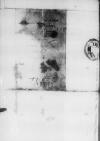Molesto tulissemus animo incendium, quod Paternitas Tua in bonis episcopatus sui pertulit, si id non a Deo permissum esset. Sed cum praeter Dei voluntatem nec capillus quidem capitis cadit, aequo ferenda sunt animo omnia, etSigismund I Jagiellon (Zygmunt I) (*1467 – †1548), King of Poland and Grand Duke of Lithuania (1506-1548); Duke of Głogów (Glogau) (1499-1506), Duke of Opava (1501-1506), Governor of Silesia (1504-1506); son of King Kazimierz IV Jagiellon and Elisabeth of Austria⌊ maiestas regiaSigismund I Jagiellon (Zygmunt I) (*1467 – †1548), King of Poland and Grand Duke of Lithuania (1506-1548); Duke of Głogów (Glogau) (1499-1506), Duke of Opava (1501-1506), Governor of Silesia (1504-1506); son of King Kazimierz IV Jagiellon and Elisabeth of Austria⌋, dominus et coniunx noster colendissimus, dicere solet totum fere regnum in centum annis propter incendia oportere renovari. Quod cum ita sit, mitiore animo ferat Paternitas Tua.
Fabian Wojanowski (Fabian of Dąbrówka, Fabian Damerau) (†1540), courtier of King Sigismund I Jagiellon and Queen Bona Sforza, German tutor to their son Sigismund II Augustus. In 1531 he went back to his family name Damerau; Dantiscus' companion on his mission to Emperor Charles V and his successor as a royal envoy at the Imperial court; 1539-1540 Canon of Ermland (Warmia) (from 1538 coadiutor of Henryk von Snellenberg by Dantiscus' patronage) (KOPICZKO 2, p. 49; SBKW, p. 37)⌊FabianumFabian Wojanowski (Fabian of Dąbrówka, Fabian Damerau) (†1540), courtier of King Sigismund I Jagiellon and Queen Bona Sforza, German tutor to their son Sigismund II Augustus. In 1531 he went back to his family name Damerau; Dantiscus' companion on his mission to Emperor Charles V and his successor as a royal envoy at the Imperial court; 1539-1540 Canon of Ermland (Warmia) (from 1538 coadiutor of Henryk von Snellenberg by Dantiscus' patronage) (KOPICZKO 2, p. 49; SBKW, p. 37)⌋, aulicum nostrum, nonnulla nobis Paternitatis Tuae verbis disserentem, non illibenter audivimus, in hisque, ut ex voto transigi possint, elaboravimus, quemadmodum ex eius litteris arbitramur intellecturam Paternitatem Tuam. Quam bene valere optamus.


 BCz, 1601, p. 640
BCz, 1601, p. 640